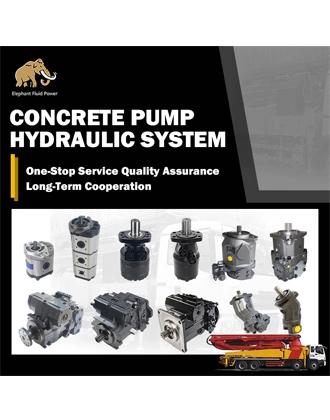Ferguson hydraulic system plays a crucial role in tractor equipment with its efficient performance. However, when the ferguson hydraulic system malfunctions, identifying and solving the problem is key to ensuring the equipment operates normally. By conducting a detailed inspection of different states of the hydraulic system, we can effectively diagnose the cause of the failure. Here are some important inspection items to help you quickly locate issues within the ferguson hydraulic system.
Checking Oil Pressure in the Ferguson Hydraulic System
Oil pressure is the primary aspect of fault diagnosis for the ferguson hydraulic system. Checking the hydraulic system's oil pressure involves not just measuring whether the pressure is too high or too low, but also observing the pressure pulsation. Typically, hydraulic systems experience some pressure pulsation due to the pump's operation. For instance, a plunger pump generates inherent flow pulsations during suction and discharge, which is generally normal. However, abnormal pressure pulsations in the hydraulic system may indicate a fault in the system components. Such mechanical vibrations can cause irregular pressure and flow fluctuations, affecting system stability. Monitoring these abnormal fluctuations provides valuable information for further fault diagnosis.
Checking Temperature in the Ferguson Hydraulic System
The temperature condition of the hydraulic system directly impacts its operational efficiency and safety. Similar to measuring body temperature during a health check-up, checking the oil temperature in the ferguson hydraulic system is essential. Issues such as component wear or leakage can lead to increased oil temperature. To get a comprehensive understanding of the hydraulic system's temperature condition, the following aspects should be checked:
Temperature of the oil in the reservoir
This is the most basic check. Abnormal rises in oil temperature usually indicate problems within the system.
Temperature of high-speed rotating bearings
Changes in bearing temperature can reveal wear or poor lubrication issues.
Temperature of the pump casing and output oil
Abnormal temperatures in these components might suggest internal faults in the pump.
Internal temperature field of the hydraulic pump
Although more complex to check, understanding the internal temperature of the pump can help identify potential internal stress issues.
Checking Oil Cleanliness in the Ferguson Hydraulic System
Impurities and pollutants in the oil can cause system failures, making regular checks of oil cleanliness necessary. The inspection items include:
Oil viscosity
Excessively thick oil will affect fluidity, while overly thin oil may cause leakage. Checking the oil's viscosity can help determine the lubrication condition of the system.
Particle detection
By detecting particles in the oil, such as iron filings and dust, we can locate worn components in the system. For example, finding more copper filings may indicate an issue with copper components in the system.
Degree of oil contamination
Statistics show that over 60% of hydraulic system failures are related to oil contamination. Thus, maintaining oil cleanliness is crucial for extending the system's lifespan.
By conducting the above checks on the ferguson hydraulic system, you can effectively identify and resolve system failures, ensuring stable operation of the equipment. Accurate fault diagnosis and timely maintenance will help you reduce downtime and enhance the overall performance of the system.
 French
French
 Portuguese
Portuguese
 Russian
Russian
 German
German
 Spanish
Spanish
 Japanese
Japanese
 Korean
Korean
 Irish
Irish
 Greek
Greek
 Turkish
Turkish
 Italian
Italian
 Danish
Danish
 Romanian
Romanian
 Indonesian
Indonesian
 Czech
Czech
 Afrikaans
Afrikaans
 Swedish
Swedish
 Polish
Polish
 Basque
Basque
 Catalan
Catalan
 Esperanto
Esperanto
 Hindi
Hindi
 Lao
Lao
 Albanian
Albanian
 Amharic
Amharic
 Armenian
Armenian
 Azerbaijani
Azerbaijani
 Belarusian
Belarusian
 Bengali
Bengali
 Bosnian
Bosnian
 Bulgarian
Bulgarian
 Cebuano
Cebuano
 Chichewa
Chichewa
 Corsican
Corsican
 Croatian
Croatian
 Dutch
Dutch
 Estonian
Estonian
 Filipino
Filipino
 Finnish
Finnish
 Frisian
Frisian
 Galician
Galician
 Georgian
Georgian
 Gujarati
Gujarati
 Haitian
Haitian
 Hausa
Hausa
 Hawaiian
Hawaiian
 Hebrew
Hebrew
 Hmong
Hmong
 Hungarian
Hungarian
 Icelandic
Icelandic
 Igbo
Igbo
 Javanese
Javanese
 Kannada
Kannada
 Kazakh
Kazakh
 Khmer
Khmer
 Kurdish
Kurdish
 Kyrgyz
Kyrgyz
 Latin
Latin
 Latvian
Latvian
 Lithuanian
Lithuanian
 Luxembourg
Luxembourg
 Macedoniar
Macedoniar
 Malagasy
Malagasy
 Malay
Malay
 Malayalam
Malayalam
 Maltese
Maltese
 Maori
Maori
 Marathi
Marathi
 Mongolian
Mongolian
 Burmese
Burmese
 Nepali
Nepali
 Norwegian
Norwegian
 Pashto
Pashto
 Persian
Persian
 Punjabi
Punjabi
 Serbian
Serbian
 Sesotho
Sesotho
 Sinhala
Sinhala
 Slovak
Slovak
 Slovenian
Slovenian
 Somali
Somali
 Samoan
Samoan
 Scots Gaelic
Scots Gaelic
 Shona
Shona
 Sindhi
Sindhi
 Sundanese
Sundanese
 Swahili
Swahili
 Tajik
Tajik
 Tamil
Tamil
 Telugu
Telugu
 Thai
Thai
 Ukrainian
Ukrainian
 Urdu
Urdu
 Uzbek
Uzbek
 Vietnamese
Vietnamese
 Welsh
Welsh
 Xhosa
Xhosa
 Yiddish
Yiddish
 Yoruba
Yoruba
 Zulu
Zulu







